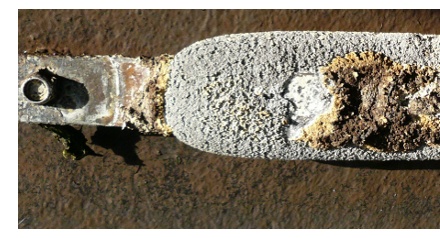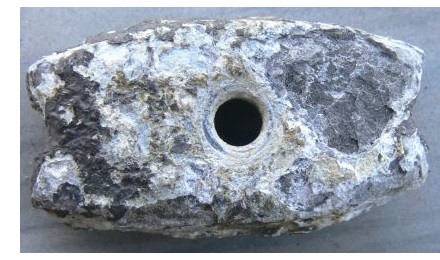Sacrificial Anodes
A galvanic anode is the main component of a galvanic cathodic protection system
used to protect buried or submerged metal structures from corrosion.
They are made from a metal alloy with a more "active" voltage
(more negative reduction potential / more positive electrochemical potential)
than the metal of the structure that has to be protected.
The difference in potential between the two metals means that the
galvanic anode corrodes, so that the anode material is consumed in preference to the structure metal.
Because of the loss of the anode material in this system, they are also called sacrificial anode.
 In marine environments, sacrificial anodes are used to prevent or reduce corrosion of
underwater metals such as propellers, bronze through-hull fittings, and stainless-steel
propeller shafts and rudderstocks.
Each of these metals should be protected by a sacrificial anode, either directly or indirectly
through the vessel’s grounding system.
Most propellers for example are made of a brass alloy such as manganese bronze, which contains
zinc and is particularly susceptible to corrosion if not protected by a sacrificial anode.
In marine environments, sacrificial anodes are used to prevent or reduce corrosion of
underwater metals such as propellers, bronze through-hull fittings, and stainless-steel
propeller shafts and rudderstocks.
Each of these metals should be protected by a sacrificial anode, either directly or indirectly
through the vessel’s grounding system.
Most propellers for example are made of a brass alloy such as manganese bronze, which contains
zinc and is particularly susceptible to corrosion if not protected by a sacrificial anode.
Anode materials
There are three main metals used as galvanic anodes, magnesium, aluminium and zinc.
They are all available as blocks, rods, plates or extruded ribbon.
Each material has advantages and disadvantages.
Magnesium has the most negative electro-potential of the three (see galvanic series) and is more
suitable for areas where the electrolyte (soil or water) resistivity is higher.
This is usually on-shore pipelines and other buried structures, although it is also used on boats
in fresh water and in water heaters.
In some cases, the negative potential of magnesium can be a disadvantage: if the potential of
the protected metal becomes too negative, hydrogen ions may be evolved on the cathode surface
leading to hydrogen embrittlement or to disbonding of the coating.
Where this is a possibility, zinc anodes may be used.
Zinc and aluminium are generally used in salt water, where the resistivity is generally lower.
Typical uses are for the hulls of ships and boats, offshore pipelines and production platforms,
in salt-water-cooled marine engines, on small boat propellers and rudders,
and for the internal surface of storage tanks.
Zinc is considered a reliable material, but is not suitable for use at higher temperatures,
as it tends to passivate (becomes less negative); if this happens, current may cease to flow
and the anode stops working.
Zinc has a relatively low driving voltage, which means in higher-resistivity soils or water
it may not be able to provide sufficient current.
However, in some circumstances — where there is a risk of hydrogen embrittlement, for example —
this lower voltage is advantageous, as overprotection is avoided.
Aluminium anodes have several advantages, such as a lighter weight, and much higher capacity than zinc.
However, their electrochemical behaviour is not considered as reliable as zinc,
and greater care must be taken in how they are used.
Aluminium anodes will passivate where chloride concentration is below 1446 parts per million.
Anode capacity is an indication of how much material is consumed as current flows over time.
The value for zinc in seawater is 780 Ah/kg but aluminium is 2000 Ah/kg, which means that,
in theory, aluminium can produce more (protective) current than zinc before being depleted.
The amount of current required corresponds directly to the surface area of the metal
exposed to the soil or water, so the application of a coating drastically reduces the
mass of anode material required. The better the coating, the less anode material is needed.
Marine Applications
While commonly simply referred to as zincs anodes, these sacrificial anodes are in fact
available in several different alloys including aluminium, magnesium and zinc.
All anodes contain alloying and trace elements of other metals.
In fact, each metal alloy is best suited to a specific environment.
Most common, fiberglass vessels cruising in seawater employ anodes made from a
zinc alloy. However, they are not necessarily the most desirable option.
Both aluminium and zinc anodes will work well in marine applications but they will
have different benefits depending on where the vessel is.
In brackish water where the salinity is much less, aluminium has definitely more advantages
over zinc. In seawater, both can be used equally well, but it is obvious that only one type
of alloy must be used.
As for magnesium anodes, these work in fresh water only and should only be used if the
vessel is operated on inland lakes and rivers.
| Aluminium Anodes | Zinc Anodes |
- Can be applied in salt and brackish water
- Aluminium anodes remain active after having been exposed to air and will reactivate when re-immersed
- Aluminium has larger anode capacity (2000 Ah/kg), so aluminium can last longer with less frequent changes and less maintenance cost
- Aluminium anodes are Cadmium free
- Lighter to ship and to fit
|
- Applicable in salt water only
- Zinc anodes form a coating if exposed to air, making them inactive when re-immersed
- Zinc provides excellent anti corrosive protection (hence the use to galvanise steel)
- Zinc has lower anode capacity (800 Ah/kg), so these anodes must be replaced more often
- More even decay across the anode
- Traditionally used by the maritime industry so widely available
|
Zinc alloys are commonly used as general purpose protective anode material.
As a result, they are generally available at a reasonable cost, but they come with some flaws.
When used in brackish or fresh water zinc anodes are prone to developing a calcareous coating,
a whitish material that essentially makes a zinc anode inactive.
 Many sailors mistakenly perceive these especially 'long-living' zincs as effective.
In reality, even where anodes are still present, they provide no anodic protection at all.
An anode that lasts for an inordinately long time probably isn’t working for any number of reasons,
calcareous coating or otherwise.
Many sailors mistakenly perceive these especially 'long-living' zincs as effective.
In reality, even where anodes are still present, they provide no anodic protection at all.
An anode that lasts for an inordinately long time probably isn’t working for any number of reasons,
calcareous coating or otherwise.
Aluminium anodes have a greater electrical potential to absorb corrosion (up to 50% more)
Zinc anodes tend to dissolve more evenly and completely; while typical aluminium anodes erode unevenly with visible “craters”.
Aluminium anodes can develop soft white or grayish surfaces which tend to prohibit the anode from dissolving completely
however there have been many examples where aluminium far out performs zinc by corroding more slowly.
This in itself can create a great cost saving.
Aluminium does have some other great benefits over zinc.
Most aluminium anodes do not contain cadmium, which is harmful to the marine population,
so they have a ‘smaller’ environmental footprint than zinc anodes.
There needs to be an essential part of cadmium in zinc anodes to ensure they work in
the anodic way rather than simply a lump of zinc (anodes work on the surface area).
Aluminium anodes, alternatively, offer several advantages.
They’re immune to the calcareous coating menace and are therefore well suited
for use in seawater, as well as brackish and fresh water.
Aluminium anodes also have more protection capacity.
Their relative energy capacity is about 2000 Ah/kg (significantly more than zinc with 800 Ah/kg), so
they either last longer than zinc anodes of the same weight, or provide the same
protection as zinc in a lighter package.
Quality of any anode is essential.
Whether zinc or aluminium, the grade and the composition are key to the effectiveness of the anode.
Some cheaper suppliers use scrap metal in their manufacturing process which means that the quality of the
metal and any other compounds affect the ability for the anode to provide adequate protection.
These cheap anodes often don’t meet the required standards.
An important thing to remember is that for the anode to be effective it must be electrically connected to the
parts it is intended to protect.
When attaching a zinc anode to a prop or shaft, the point of surface attachment must be clean and "bright"
so a good electrical contact is assured.
Also, an anode should never be covered with bottom paint, because this will electrolytically isolate the
anode and impede it from its intended purpose.
|
 In marine environments, sacrificial anodes are used to prevent or reduce corrosion of
underwater metals such as propellers, bronze through-hull fittings, and stainless-steel
propeller shafts and rudderstocks.
Each of these metals should be protected by a sacrificial anode, either directly or indirectly
through the vessel’s grounding system.
Most propellers for example are made of a brass alloy such as manganese bronze, which contains
zinc and is particularly susceptible to corrosion if not protected by a sacrificial anode.
In marine environments, sacrificial anodes are used to prevent or reduce corrosion of
underwater metals such as propellers, bronze through-hull fittings, and stainless-steel
propeller shafts and rudderstocks.
Each of these metals should be protected by a sacrificial anode, either directly or indirectly
through the vessel’s grounding system.
Most propellers for example are made of a brass alloy such as manganese bronze, which contains
zinc and is particularly susceptible to corrosion if not protected by a sacrificial anode.  Many sailors mistakenly perceive these especially 'long-living' zincs as effective.
In reality, even where anodes are still present, they provide no anodic protection at all.
An anode that lasts for an inordinately long time probably isn’t working for any number of reasons,
calcareous coating or otherwise.
Many sailors mistakenly perceive these especially 'long-living' zincs as effective.
In reality, even where anodes are still present, they provide no anodic protection at all.
An anode that lasts for an inordinately long time probably isn’t working for any number of reasons,
calcareous coating or otherwise.